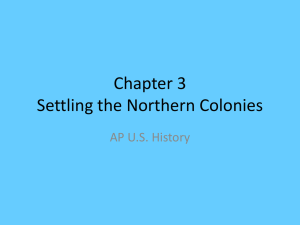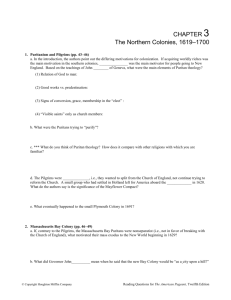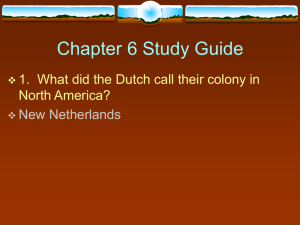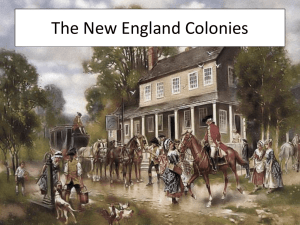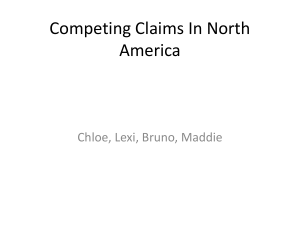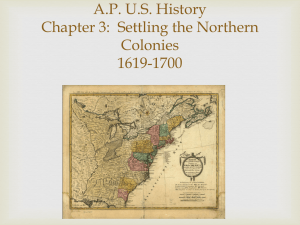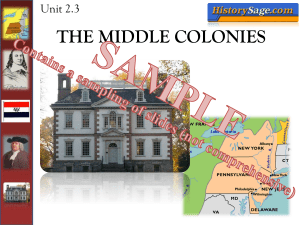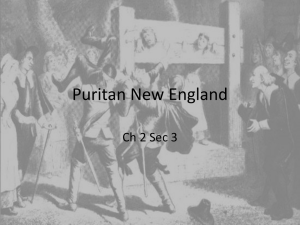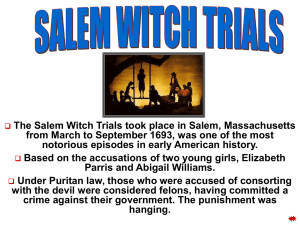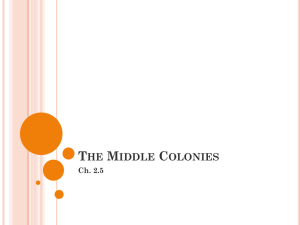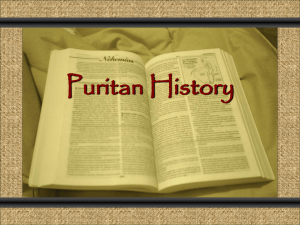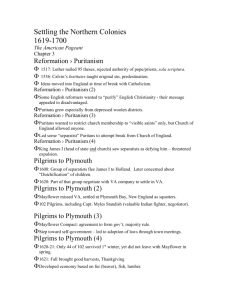Chapter 3 Powerpoint
advertisement
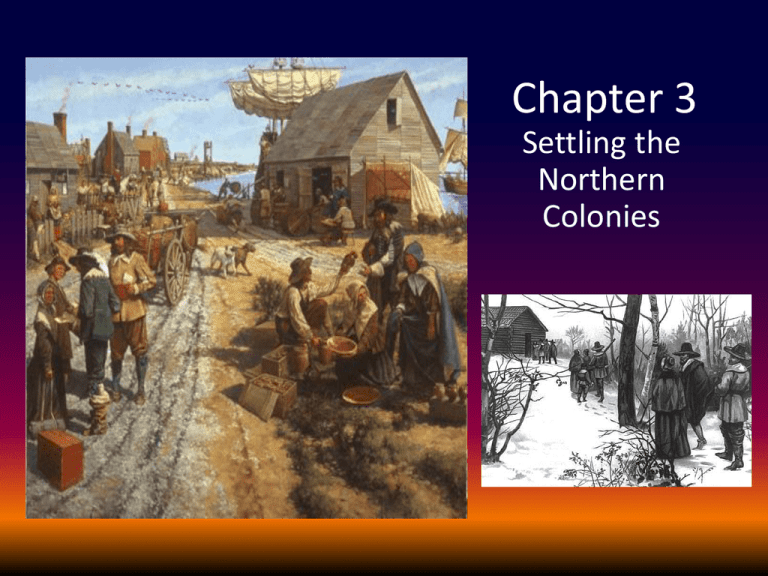
Chapter 3 Settling the Northern Colonies Protestant Reformation: Martin Luther’s Theory: believed that the Bible alone was God’s word. John Calvin’s Theory: foundation for New Eng Puritans and other settlers. Adopted the Institutes of the Christian Religion - God was all powerful. CALVINISM: Humans, due to original sin, were weak/wicked and that only God knew who was going to Heaven or Hell. Classes of People: a. “the elect” - people going to Heaven b. “visible saints” - people predestined to go to Heaven and were the only group admitted for church membership. Beliefs: a. predestination - decision had already been made as to who was going to Heaven/Hell-status couldn't be changed through goods works on earth b. conversion - process of revelation to those “elect” in which it was revealed that they were going to heaven Calvinism spread because of the depressed status of the yeomen. Between the reigns of James I and Charles I Calvinism took root, a group emerged that would not sit in the same pews with the “damned” and they vowed to break away completely from the Church of England. King James I harassed this group into leaving England. Those that were harassed became known as Separatists. Two groups of Separatists: 1. Pilgrims – Plymouth a. 1st group to leave Eng. went to Holland; negotiated with the Va Co for passage to the New World. b. Leader: Myles Standish Ship: Mayflower. c. Due to storms, landed n. of the Va Colony -Plymouth/squatters c. Mayflower Compact - document that stated that the Pilgrims would follow only those laws they that they themselves passed by majority vote. d. Elected William Bradford as governor--serve for 30 yrs e. 1691 - merged w/ Mass. Bay Colony 2. Puritans a. More moderate (than the Pilgrims) wanted to reform the Church of Eng, however, after several unsuccessful tries, they left for the New World in 1629. b. They secured a royal charter from the Mass Bay Co./settled in Boston. c. Appointed Gov John Winthrop and marks the first mass migration to the New World. (+/- 75,000 Puritans leave Eng but only +/- 27,000 came to the US region.) d. Colony flourished--fur trade, fishing, and shipbuilding industries. e. Religious practice: believed that they had a covenant (agreement) with God to build a “holy” city/a model for mankind in the New World. Soon after arriving, franchise was extended to Freemen - adult males who made up the “elect”/ “visible saints”/belonged to the Puritan congregation, eventually formed the Congregational Church. f. Government: Town governments – all male property owners & ruled by majority vote. Basis of all of their laws revolved around enforcing God’s laws to believers and nonbelievers. Everyone paid taxes to support the gov’t and Congregational Church. Supporter: John Cotton - spent time defending the gov’t’s duty to enforce religious rules. He believed that the power of the preacher was NOT absolute - congregation could hire/fire/set salaries. Cotton also believed clergymen were to be barred from holding public office (idea of separation of Church and State). Dissenters of the Puritan Faith: Quakers - vocally disagreed with the power given to the clergy/were fined, flogged, and/or ultimately banished Anne Hutchinson - believed in antinomianism claimed that due to predestination (set course in life), it didn’t mattered what one did here on earth because they were already set to go to Heaven--didn’t have to follow man’s laws. She boasted that they idea of antinomianism came to her by direct revelation from God. Puritan clergy wouldn’t hear of anyone not following their (God’s) laws/banished her to Rhode Island and eventually she went to New York. Roger Williams - Salem minister, denied the belief that the civil government could regulate religious behavior. He was banished and went to Rhode Island. There, Wms set up his own Puritan church, the Baptist Church which called for complete freedom of religion, even for Jews/Catholics/Quakers. There were NO: a. oaths of religious beliefs b. no mandatory attendance policy for worship c. no taxes collected would support the Church. d. Also practiced simple manhood suffrage - did away with requirement to hold property = vote. Result: RI consisted of misfits and those banished from other colonies. They became strongly individualistic and stubbornly independent. Migration: 1. Hartford, Connecticut (1635) Boston Puritans, under Rev. Thomas Hooker, moved s. for eco./agrarian reasons. After 3 yrs. created the Fundamental Orders (of Connecticut) which established a gov’t based upon the decision of the majority of its citizens. (Later importance - provides framework for our own US Constitution) 2. New Haven, Connecticut (1638) - Boston Puritans who moved s. in an effort to tighten the tie between Church and State. Became a prosperous seaport. 3. Mass. Bay Colony (1677) - due to the success of the fishing and fur trade, spread n. to encompass what is now part of Maine. 4. New Hampshire Colony (1677) originally owned by the Gorges family, sold to the Mass Bay Colony because of the location and success of the fishing/trade industries. Later, New Hampshire will split from the Mass. Bay Colony and form its own colony (1679). Rising Threat and Seeds of Independence 1. 1643 - Formation of the New England Confederation (Massachusetts Bay, Plymouth, New Haven, and scattering of settlements along the coast - didn’t include Maine and Rhode Island too many heretics) Goals: 1. common defense against the enemy (Ind., Fr., and the Dutch) encroaching on their land. 2. handled intercolonial problems 3. each colony had two votes 4. exclusive Puritan Club Importance: Because of the coordination of the Confederation, the Colonists were successful in King Philip’s War (1675-1676) 2. Dominion of New England - Created by royal authority to regain colonial control. Areas Affected: Massachusetts Bay, Plymouth, RI, Conn, NH Goals: 1. Bolster colonial defense against the Indians 2. Part of the English Navigation Laws -limited colonial trade to just England (no other countries) Promoted by Edmund Andros whose headquarters was in Boston. 1. cut back town meetings 2. placed heavy restrictions on the courts, press, and schools (to enforce England’s laws) 3. revoked all land titles - placed people under his control 4. did away w/ popular assemblies 5. taxed colonists without representation 6. tried to enforce the Navigation Laws - resulted in smuggling. Andros’s reign of terror collapsed when the Glorious (bloodless) Revolution took place in Eng. whereby James II (Catholics) was replaced by William III (Protestant). Effects of the Glorious Revolution on the Colonies: 1. Unrest 2. Abandonment of Andros’ system of gov’t 3. Breakdown of the Navigation Laws 4. More British official came to the colonies and tried to block local leaders from colonial political positions. Threat from the Dutch/Swedes New Netherland - Dutch E. India Co. commissioned Henry Hudson in 1609 to explored the area between the Puritan colonies in the n. and the s. Eng. colonies in the south--Explored the Delaware Bay and New York Bay, Hudson River, and n. to Hudson Bay in Canada--became a prosperous fur trading area. Dutch E. India Co. bought Manhattan Island from the Indians for trinkets - purpose to protect the Hudson River area. Renamed Manhattan Island - New Amsterdam. Entire Dutch area was set up with patroonships - huge feudal estates fronting the Hudson River which were obtained when the Dutch gathered 50 people to apply for the land. Consequence: attracted a cosmopolitan population with 18 different languages spoken. Patroonships were led by director-generals who actually turned out to be quite greedy and inadequate in protecting the settlers from Indian attacks. To gain security, the Dutch built a wall around New Amsterdam to protect them from the Indians (hence Wall Street) Swede threat: Swedes settled along the Delaware River and began to spread out towards the Dutch. The Dutch sent General Peter Stuyvesant “Father Wooden Leg” to get rid of the Swedes. The battle was bloodless and thus the Swedish claim along the Delaware was absorbed by the Dutch. (16381655) English threat: (1664) King Charles II didn’t like the fact that the Dutch and Swedes were able to claim land in the New World. After the Dutch removed the Swedes, King Charles II sent his brother the Duke of York to get rid of the Dutch. Stuyvesant, without supplies, had to surrender, thus New Amsterdam was renamed New York. Rise of the Quakers: Separatists, known as the Society of Friends (nicknamed Quakers), refused to support the Church of England and their numbers increased in the English colonies. Characteristics: 1. simple meeting places 2. had no paid clergy 3. spoke for themselves 4. did not require any oaths 5. advocated passive resistance - refused military service. Location: RI, NC, NJ Quakers attracted Englishman William Penn who established Pennsylvania. 1. Obtained a land grant from the King. 2. Became the “First advertising man” because he sent out advertisements in different languages for people to join him when he went to the New World-particularly artisans. 3. Created Philadelphia - carefully planned out city 4. Bought land (for a reasonable value) from Chief Tammany and treated the Indians well. 5. Government – a. liberal and included representative assemblies of land owners b. religious freedom (although forced to deny Jew and Catholics from voting and holding public office by the King) c. Imposed the death penalty only for treason and murder. d. opposed black slavery 6. Produced/exported a lot of grain products. 7. Members also spread to land made available by two English nobles in what is now NJ, then East and West New Jersey) Characteristics of the Middle Colonies NY, NJ, DEL, PA 1. fertile soil 2. booming fur trade 3. industry flourished lumbering and shipbuilding 4. natural harbors – commerce grew 5. landholdings were medium in size, except in New York 6. moderate forms of government 7. more ethnically diverse 8. greater degree of religious tolerance 9. land was easy to acquire.
